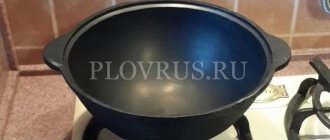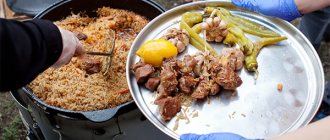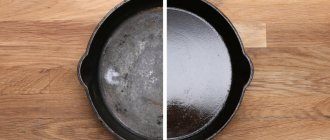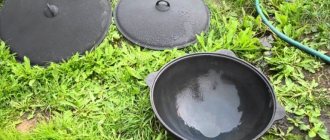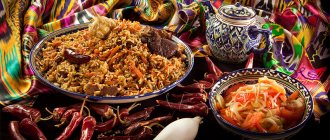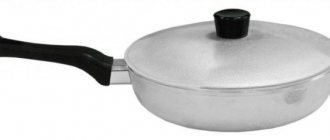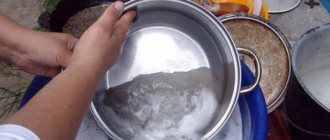Pilaf, stewed meat - I thought, and my mouth began to water. Tasty! Of course, you can cook these culinary masterpieces in an ordinary saucepan. But in a specialized cauldron, these dishes turn out to be finger-licking.
A cauldron is a saucepan with a round bottom. They are made from cast iron, aluminum, and other metal alloys. But the latter are extremely rare and are often used to decorate the kitchen.
A new cauldron requires the attention of the hostess. Before the first cooking, it needs to be heated. Experienced chefs recommend buying an already used cauldron. So, they say, the dishes turn out tastier, and you can skip the mandatory calcination procedure.
Why experiment with high temperatures? The fact is that metal products - any kind - are poured into molds. To separate a cast iron or aluminum cauldron or pan from the mold, it is coated with a layer of technical oil. As a mistress of the mold when baking cupcakes. If you do not want to enjoy the taste and smell of machine lubricant instead of pilaf, then before 1 use the dishes must be calcined. This will remove any remaining grease.
Which cauldron is better, aluminum or?
In general, an aluminum cauldron is an affordable and easy-to-use option. ... Which cauldron is better: cast iron or aluminum
| Properties | Cast iron cauldron | Aluminum cauldron |
| Cooking speed | long languor | quick cooking |
| Recommended Use | at the stake | on the stove |
| Warm-up speed | takes a long time to warm up | heats up quickly |
| Weight | heavy | easy |
Interesting materials:
How to get Staly Pobyt? How can a Ukrainian obtain refugee status in Russia? How to obtain refugee status in Germany 2022? How to obtain refugee status in Germany? How to obtain refugee status in Italy? How to obtain refugee status in Israel? How to obtain refugee status in Poland? How to obtain refugee status in Russia? How to obtain refugee status in the USA? How to obtain refugee status in the UK?
Using oil for calcination
After completely burning out the harmful oil, another film of oil needs to be formed on the walls of the new cauldron. Only vegetable oil is already used.
The volume of your cauldron matters here. Usually a minimum of 500 – 1000 ml of oil is required to cleanse. It is poured into a cauldron. It is placed on low heat for 30 minutes. During such boiling, the cauldron must be periodically tilted so that its walls are completely covered with the required film.
Then the stove turns off. The oil is cooling. It is drained from the cauldron. The cauldron itself should be cleaned with warm water. Detergents must not be used. The dishes are wiped dry. You need to walk along its internal surfaces with a rag previously soaked in natural oil. Your new aluminum cauldron is now ready for use. Please note that if not handled properly, the oil may ignite.
Caring for an aluminum cauldron is quite troublesome than preparing it for use. Its protective film can be easily removed due to harsh cleaning devices: washcloths and brushes.
And if you want to purchase an aluminum product that will largely replace the thick-walled cast iron Tatar analogue, the walls of this product must be at least 1 cm thick.
What is the difference between a cauldron and a saucepan?
Since ancient times, the peoples inhabiting Central Asia have used cauldrons to prepare traditional dishes. Despite the fact that many other convenient utensils have appeared today, this time-tested device is only gaining more and more popularity.
The cauldron differs from a regular saucepan in its rounded shape, which allows you to conveniently lower the brew into the fire. At the same time, both the bottom and the walls of the cookware heat up. Thanks to this device, the dish is prepared quickly, and the food is heated evenly.
Translated from Turkic, the word “kazan” means “a vessel that has been scraped out.” It can be mounted on a tripod placed in the fire. The hearth will be a shallow pit with a fire built in it or a pile of cobblestones under which the fire glows.
Why are cast iron cauldrons calcined?
But really, why? After all, in stores, it would seem, they should sell something that is already ready for use, that is, the dishes need to be thoroughly washed and dried. But in practice this is not entirely true - this rule does not apply to cookware made of cast iron and some other materials. Cast iron is susceptible to rust - long-term storage inevitably leads to the appearance of corrosion marks. To prevent this, manufacturers coat cast iron cookware with an oil-based technical lubricant.
Now imagine what will happen if you start cooking pilaf without preparing the cauldron properly? Or just rinse it with water? The porous structure of the material at high temperatures will seal this chemical smell inside forever, and all you have to do is throw away the cauldron or turn it into a flower pot.
Conclusion: a cast iron cauldron must be calcined before first use.
Customer Reviews
Leonid Minin Kazan Kukmara is a weighty dish. I am sure that it will not break or bend during transportation. It is important to properly remove the factory coating and immediately read on the Internet how to clean it from the inside and outside. The dishes are worth it!
Svetlana. Ekaterinburg I bought a 5 liter cauldron especially for my husband. He is my classic hunter. That’s why I gave her a 5-liter aluminum cauldron. We don’t use it at home, but it’s a pleasure to use it outdoors, if you know how to cook and love it. They say that aluminum is not a material for food utensils, but, as I think, a cauldron is made of an alloy. Therefore, when heated, there will be no poison in the food, and even if this is possible, then such a product will not be allowed for sale.
Kinds
In shops selling tableware, you can see many cauldrons, which at first glance are very similar to each other. However, all models differ in shape, volume, weight and the material from which they are made. To choose the right thing, you need to take into account all the nuances.
FORM
The classically shaped cauldron is made in the form of a hemisphere. This type of cookware is the most popular and is used mainly for cooking over an open fire. Due to the convex bottom, a device of this shape cannot be placed on a flat surface.
Recently, models with a flat bottom have begun to appear on sale. In such dishes you can easily cook on a regular kitchen stove. Now you can enjoy food from the cauldron without leaving your apartment. A traveling cauldron can be hemispherical or flat.
VOLUME
The volume of the cookware does not affect the cooking process - the main thing is that there is a small amount of free space in the container for stirring the food. For a family of four, 3 liters of dishes is enough. If you purchase an 8-liter cauldron, you can feed 16 people with pilaf. Especially tasty and juicy dishes are obtained in large cauldrons, the volume of which exceeds 15 liters.
LID
Many models are equipped with lids made of the same material as the main part of the vessel. However, it happens that they offer to take an aluminum or even wooden lid for a cast iron product.
Here we must remember that the material is not as important as the tightness of the lid to the edges of the main container. The diameters of the lid and pan must match perfectly, otherwise the desired effect will not be achieved.
WALL THICKNESS
The wall thickness of the cauldron should be at least 3 cm, but not more than 6 cm. However, you can use options with a slightly larger or smaller thickness. It is not advisable to buy specimens with a wall thickness of up to 10 mm. It should be remembered that a thick-walled cauldron captures and retains temperature better.
Reference. There is no doubt that of all types of cauldrons, preference should be given to utensils made of cast iron or aluminum. Although, in order to make the right choice, you need to take into account all the nuances: volume, shape, availability of additional devices.
MATERIAL
Perhaps the material from which the product is made is the most important factor influencing the choice of a cauldron. There are several types of cookware:
- With Teflon or enamel coating. Modern, but not ideal cookware for use on an open fire. Due to strong heating, the coating in such models quickly cracks, peels off, and gets into food. In addition, in Teflon-coated dishes, you need to stir food with a special spatula, or better yet, not stir at all, which violates the cooking technology.
- Copper. Copper cauldrons are used extremely rarely, although residents of some countries (Azerbaijan, Uzbekistan) prefer models made of this metal. The low popularity of copper cookware is explained by the fact that copper easily corrodes; does not hold the temperature required for cooking well; After each use, the cauldron requires thorough cleaning.
- Aluminum. The most popular material after cast iron. Great not only for cooking over an open fire, but also for use on a gas and electric stove.
- Cast iron. Perfect option. Cast iron cauldrons are very heavy and take a long time to warm up, but dishes cooked in such dishes are incredibly aromatic and pleasant to the taste.
Teflon coating must be handled very carefully. If you heat a cauldron without fat, it may be damaged. In addition, the mechanical impact in this case does not pass without consequences.
Creating a non-stick layer
Having figured out how to heat a cast iron cauldron, you need to try to make sure that during the cooking process food does not stick to its bottom. To create a non-stick coating, you need to grease a dry container with a large amount of vegetable oil and place it on a paper towel. To remove drips, you can use napkins.
After getting rid of excess oil, the cauldron must be placed in the oven, preheated to 180 degrees and lined with foil. The container should stand there for three hours. This time is enough for a strong and thin layer to form on the walls of the dish, preventing food from burning.
Having understood how to heat a cast iron cauldron at home, you need to figure out how to extend its service life. In order for such dishes to serve your family well for several decades, you should provide them with proper care.
Don’t forget to transfer still hot food to another bowl, and immediately wash the cauldron itself with warm water without detergent. Burnt residue can be removed with steel wool.
Those who already know how to heat a cast iron cauldron will be interested in figuring out what to do if rust appears on its surface. In this case, the vessel, previously washed and filled with vegetable oil, must be heated over high heat for ten minutes.
One of the main disadvantages of cast iron containers is their ability to absorb any odors. To get rid of a persistent foreign aroma, you need to fill a cauldron with a kilogram of table salt and put it on maximum heat. After thirty to forty minutes, you can empty the contents of the dish, cool it and wipe the inner walls with clean napkins. Then you need to warm up the container again and lubricate it with vegetable oil. To facilitate the process, it is recommended to use an ordinary brush or paper.
If the outside of cast iron cookware is covered with a thick coating of soot, it can be cleaned using an old knife or spatula. If necessary, the product can be sent to a facility that allows you to quickly and accurately get rid of the burnt layer. At the end of this procedure, the cauldron should be washed with warm water and calcined with sunflower oil.
Having read books on cooking pilaf, shurpa, dumlyama and basma, you, full of stomach juices, run to buy a cast-iron cauldron to urgently cook some of the above! Having made the right choice, you rush back to the stove and prepared foods, dreaming of immediately starting gastronomic witchcraft...
Stop! There is absolutely no need to rush! Your new cauldron needs to be properly prepared for cooking. In the process of its production, technical oil is used so that the cauldron is easily and without unacceptable defects separated from the mold, and also does not rust. Of course, machine oil is absolutely not suitable for cooking pilaf! This means it needs to be removed.
There will be a lot of smoke and unpleasant odors during oil removal. It is necessary to ensure good ventilation of the kitchen. Turn on the hood, open the windows, close the doors to other rooms. It is best to carry out the procedure for preparing the cauldron for the first use in the fresh air. Therefore, if you have a dacha or a country house, take your treasure and go there.
Calcination on fire
First, wash the cauldron with warm water. Light or build a fire. The flame should be slightly above average. Place the cauldron on the fire so that it is well heated. The cauldron will begin to smoke and smell unpleasant. It is necessary to ignite over a fire until all machine oil stains disappear. This may take an hour and a half, or even more.
Attention!
If you prefer an aluminum cauldron to a cast iron cauldron, then the calcination procedure should be carried out on fire BELOW average. Otherwise, you risk being left without a cauldron, because... High temperatures can cause an aluminum cauldron to melt.
Oil calcination
The cauldron no longer smokes. Now, depending on the size, pour 400-700 ml of oil into it. This time it’s plant-based, not machine-made. The fire needs to be turned down. Under the influence of oil, the cauldron should acquire a reddish tint. There is no need to heat it up any more. Rotate the cauldron so that the oil covers all the walls, evenly distributed over it. The purpose of the oil is to heat the cauldron as much as possible. Then let the oil cool and pour it out. If you are out of town, it is advisable to turn the cauldron upside down after these steps and hold it over the flame for another 20-30 minutes.
Calcination with salt
After calcination over a fire, you can heat the cauldron not with oil, but with salt. The oil smokes strongly and can even burst into flames if handled carelessly. Pour one and a half kilograms of coarse salt into the cauldron. You also need to heat it for at least an hour until the salt turns gray. Throw away the gray salt.
Rules for firing a cauldron before first cooking
Food casting is fired so that the factory lubricant burns out. It turns into smoke and soot, which is removed with hot water and soap. The procedure for firing a cast-iron cauldron before the first cooking is lengthy and unpleasant: a fair amount of smoke is generated, and it does not smell like roses. Aluminum is processed faster; when working with it, several nuances must be taken into account. There are features of firing a cauldron.
The food turns out much tastier and more aromatic, since such dishes are cleaned of technical grease and undergo a procedure for renewing the protective coating with oil.
Note! Some manufacturers produce cauldrons with a black non-stick coating. This is a thin layer of durable enamel. It is not oily to the touch; when wiping new dishes, no stains remain on the napkin. If you pour water, rainbow stains will not appear on it.
Cast iron
Cast iron products are very heavy. Casting is done with thick walls, thanks to which the products simmer rather than boil or fry. Cast iron must be handled with care. If accidentally dropped, the metal may crack; the alloy is classified as brittle. Below is detailed instructions on how to fire a new cast iron cauldron over a fire and at home, what you will need for this.
Without proper processing, food cooked in a cauldron will simply be inedible and smell bad, and cooking in general will become impossible.
Note! Cast iron is not afraid of temperature contrasts. Previously, cast iron pots were fired in winter, thrown out of the fire into the snow, then wiped dry and put back on the fire. The procedure was repeated several times.
Aluminum
Aluminum alloy, or rather duralumin for casting, is valued for its low specific gravity. But the metal has one peculiarity: when unevenly heated, internal stresses form in it; the cauldron can become deformed if fired over high heat.
If you want to maintain the roundness of the walls and the evenness of the bottom, the metal should be heated slowly, gradually.
By the way, the thermal conductivity of aluminum is higher than that of cast iron. Food in an aluminum cauldron cools down faster and is not as flavorful.
Aluminum casting is often chosen by those who enjoy active recreation and cook in nature.
Other rules of care
After the first use of such aluminum cookware, it must be thoroughly cleaned of food residues. Under no circumstances should you soak this cauldron in water with detergents or leave it there for a long period.
It is better to immediately rinse the cauldron with clean water after use and gently wipe it dry with a sponge. This is the safest way to remove stuck food items. Then this dish is almost completely filled with water. The water is boiling. After which it merges. The dishes need to be gently wiped dry again, and then covered with a very thin layer of oil. After these procedures, the cauldron can be stored.
If for some reason your cauldron has been left unwashed for several hours, then food residues will stick to it very strongly. They were either dried out or burnt. There is only one way out - soaking the cauldron. Just do not use chemicals in this procedure. Regular warm water will do.
After thoroughly cleaning the cauldron, household salt (table salt) is placed in it and calcined. This operation takes one hour. The salt should darken and give off a nasty smell. When this happens, it pours into another container. The cauldron cools down completely. Oil is placed in it and calcined. That is, the same operation takes place as when preparing dishes for debut use.
Operating principle and design of the cauldron
A cauldron is a metal cauldron with a sloping bottom. Traditionally used for preparing Central Asian dishes. The cauldron is installed on special tripods or in the oven. Cooking stoves with chimneys are either stationary or portable.
The cauldron must be supplied with a lid, which must fit tightly, leaving no gaps for steam to escape. It is made from the same material as the cauldron or from wooden boards. Sometimes the products are equipped with a solid handle so that it can be used to hang the cauldron over the fire.
The hemispherical shape of the cauldron is intentional. It has the widest diameter at the top, becoming increasingly narrower at the bottom. When the dishes are lowered directly into the fireplace, not only the bottom itself is heated by the flame, but also the rounded sides.
The food inside receives heat much faster and remains hot for a long time, thereby saving fuel. The abundant formation of steam allows the contents not to fry, but to simmer slowly, making the food soft, crumbly and aromatic.
During cooking, all the spices have time to saturate the food, and this is another feature of the traditional cauldron.
Methods and places of calcination
It is very easy to heat a cauldron at home, but here you should pay attention to the material from which it is made. The fact is that the calcination methods for cast iron and aluminum cauldrons are slightly different.
You can carry out calcination on the street or at home. You can read more below.
Proper processing after calcination
Preparation of any cast cookware for cooking ends after the formation of a shiny film on the inner surface, which acts as a non-stick coating.
It tightly seals the pores in the metal and protects against moisture.
The process of oil preparation of a cauldron for first use:
- Dry utensils are generously lubricated with oil from the inside. External stains are removed with a cloth or paper napkins.
- Place the greased dishes in the oven or on the fire.
- Wait for the oil to start smoking.
- Transfer the casting to a stand and allow to cool slightly.
- Remove carbon deposits with paper or textiles.
- They lubricate the walls again and set them to burn.
The procedure is carried out up to 5 times.
After this, the metal cannot be washed with detergents; just pour boiling water over it and wipe it.
How to check a heated cauldron
The color of the metal should be rich, without dullness. When the natural protective layer is uneven, light is reflected differently.
True gourmets know that to prepare the most delicious food you need a cauldron.
Well-prepared dishes show no signs of rust. Control test:
- moisten a napkin with oil;
- wipe the edges and bottom.
If there are no dark marks on the paper, everything is fine. If a brown fine coating remains, it is necessary to carry out oil firing again. Food in such a container will have an unpleasant aftertaste and the food will begin to burn.
The heating of the cauldron must be carefully monitored.
Aluminum does not require special testing. For him, the main test is whether carbon deposits form on the walls. It shouldn't exist.
Existing firing techniques
Let us immediately note that the process of preparing for further operation is quite simple. It involves treatment with fire so that the factory grease disappears from the dishes, and subsequent rinsing with warm water.
Those who are interested in how to heat a new cast iron cauldron should understand that metal scourers and detergents cannot be used during the pre-treatment process. Today there are two methods of firing such products:
- Over an open fire using an outdoor oven or barbecue.
- On a gas stove or in the oven.
It should be understood that the calcination process is accompanied by the release of a large amount of smoke and fumes resulting from burning of the oil. Therefore, if the procedure is carried out indoors, it is necessary to turn on the hood in advance, as well as open doors and windows to provide a draft.
